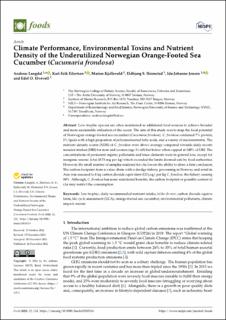| dc.contributor.author | Langdal, Andreas | |
| dc.contributor.author | Eilertsen, Karl-Erik | |
| dc.contributor.author | Kjellevold, Marian | |
| dc.contributor.author | Heimstad, Eldbjørg Sofie | |
| dc.contributor.author | Jensen, Ida-Johanne | |
| dc.contributor.author | Elvevoll, Edel O. | |
| dc.date.accessioned | 2023-01-20T10:00:50Z | |
| dc.date.available | 2023-01-20T10:00:50Z | |
| dc.date.created | 2023-01-03T09:23:19Z | |
| dc.date.issued | 2022 | |
| dc.identifier.citation | Foods. 2022, 12, 114. | en_US |
| dc.identifier.issn | 2304-8158 | |
| dc.identifier.uri | https://hdl.handle.net/11250/3044902 | |
| dc.description.abstract | Low trophic species are often mentioned as additional food sources to achieve broader and more sustainable utilisation of the ocean. The aim of this study was to map the food potential of Norwegian orange-footed sea cucumber (Cucumaria frondosa). C. frondosa contained 7% protein, 1% lipids with a high proportion of polyunsaturated fatty acids, and a variety of micronutrients. The nutrient density scores (NDS) of C. frondosa were above average compared towards daily recommended intakes (DRI) for men and women (age 31–60) but below when capped at 100% of DRI. The concentrations of persistent organic pollutants and trace elements were in general low, except for inorganic arsenic (iAs) (0.73 mg per kg) which exceeded the limits deemed safe by food authorities. However, the small number of samples analysed for iAs lowers the ability to draw a firm conclusion. The carbon footprint from a value chain with a dredge fishery, processing in Norway and retail in Asia was assessed to 8 kg carbon dioxide equivalent (CO2eq.) per kg C. frondosa, the fishery causing 90%. Although, C. frondosa has some nutritional benefits, the carbon footprint or possible content of iAs may restrict the consumption. | en_US |
| dc.language.iso | eng | en_US |
| dc.rights | Navngivelse 4.0 Internasjonal | * |
| dc.rights.uri | http://creativecommons.org/licenses/by/4.0/deed.no | * |
| dc.title | Climate Performance, Environmental Toxins and Nutrient Density of the Underutilized Norwegian Orange-Footed Sea Cucumber (Cucumaria frondosa) | en_US |
| dc.title.alternative | Climate Performance, Environmental Toxins and Nutrient Density of the Underutilized Norwegian Orange-Footed Sea Cucumber (Cucumaria frondosa) | en_US |
| dc.type | Peer reviewed | en_US |
| dc.type | Journal article | en_US |
| dc.description.version | publishedVersion | en_US |
| dc.rights.holder | © 2022 by the authors. Licensee MDPI, Basel, Switzerland. | en_US |
| dc.source.volume | 12| | en_US |
| dc.source.journal | Foods | en_US |
| dc.source.issue | 1 | en_US |
| dc.identifier.doi | 10.3390/foods12010114 | |
| dc.identifier.cristin | 2099321 | |
| dc.relation.project | UiT Norges arktiske universitet: 2061344 | en_US |
| dc.source.articlenumber | 114 | en_US |
| cristin.ispublished | true | |
| cristin.fulltext | original | |
| cristin.qualitycode | 1 | |

